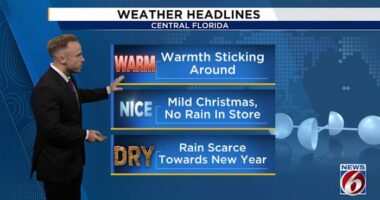Share this @internewscast.com
ST. GEORGE, Utah (KTVX) — People who are suffering from pneumonia-like symptoms lately (but don’t have pneumonia) may have ingested fungal spores that went airborne after dirt around you was disturbed. Health officials say it’s more common than you may think, especially in the Western U.S.
Valley fever, or coccidioidomycosis, is a fungal lung infection that can cause symptoms like fatigue, cough, fever, shortness of breath, and a rash. It occurs after spores from coccidioides — which live in soil and dust in parts of the United States — are breathed in.
Dr. Katharine S. Walter and Dr. Ginamarie Foglia, both epidemiologists, presented during a lecture series in southern Utah about the effects of Valley fever and concerns related to the changing environment.
‘No reason to panic’ about soil fungus: Expert
“There’s no reason to panic,” Foglia told Nexstar’s KTVX. “It’s manageable. It’s just that many people don’t know what it is.”
Foglia said that while people should not panic about the potential for these types of infections, it is important to know what the risks and symptoms are. An understanding of the symptoms could help people better manage the infection.
“Many times it’s seen as a bacterial infection, and people are given antibiotics, they don’t get better,” Foglia said. “So, it’s really to alert people and to make them aware that it exists here.”
“Cases frequently are never diagnosed or misdiagnosed because many patients are not tested for Valley fever,” the CDC says.
What is valley fever?

Valley fever occurs after spores that live in soil and dust are breathed in. When that soil or dust is disturbed (such as during construction, a windstorm or while gardening), the risk of breathing in those spores increases.
The Centers for Disease Control and Prevention reports that many people do not get sick from breathing in the spores, and most people who do fall ill get better on their own. However, some groups of people are at higher risk for developing severe forms of Valley fever.
Many people who have valley fever experience mild symptoms, including fatigue, cough, fever, headache, shortness of breath, rash, muscle aches and night sweats. People “often get better without medication within a few months,” the CDC says.
However, 5% to 10% of people who get valley fever will end up developing serious lung complications. About 1% see the infection spread out of their lungs into other parts of the body, causing issues with their brain, skin, bones or joints.
If you notice symptoms of valley fever that are lasting longer than a week, officials recommend visiting a health care provider.
“This is a disease we should all be worried about because everyone is at risk, and the people at most risk are the people who work outside, who are constantly exposed to dust and soil, like agricultural workers, construction workers,” Walter said.
Where is valley fever most common?

Valley fever is most often seen in the southwestern U.S., according to the CDC. Between 10,000 and 20,000 cases are reported to the CDC each year, with most cases reported in Arizona and California.
CDC tracking shows the fungus that causes valley fever is also known to be present in parts of Colorado, Idaho, Oregon, Nevada, New Mexico, Oklahoma, Texas, Utah, Washington and Wyoming. The fungus’ “potential range” includes several more states (see map below).

Walter said climate change could expand the areas where the fungus can be found.
“We think that with a changing climate, that the area where the fungus can thrive and survive is likely to expand and change, and that’s one thing we really need to study,” Walter said.
How do I prevent valley fever?
The CDC says it is “very difficult to avoid breathing in the fungus,” but there are still ways to help reduce exposure.
For example, the agency recommends using air filtration methods when indoors and avoiding areas (like construction sites) that have a lot of dust. Wearing an N95 respirator when around dust may also help.
Joseph Degolyer contributed to this report.











